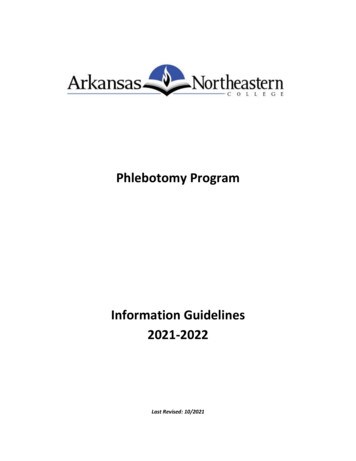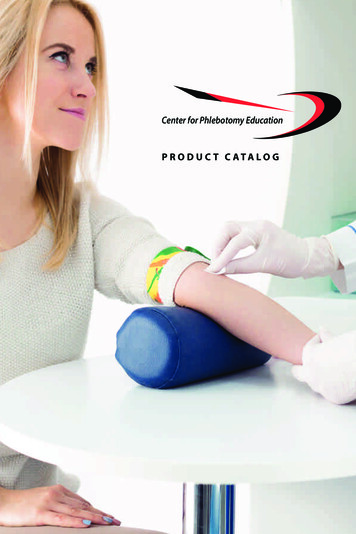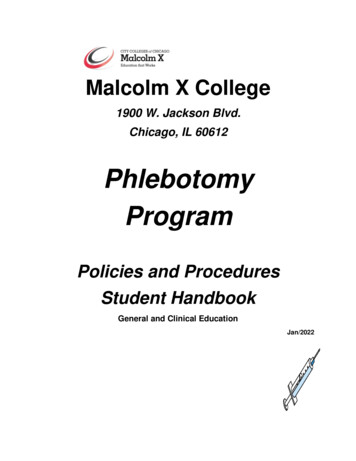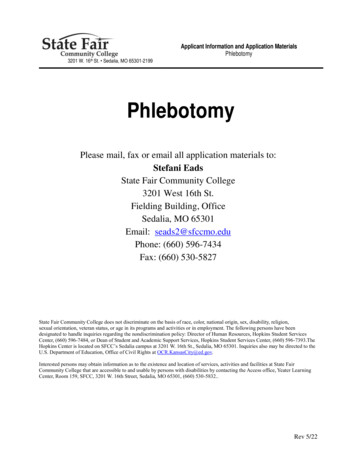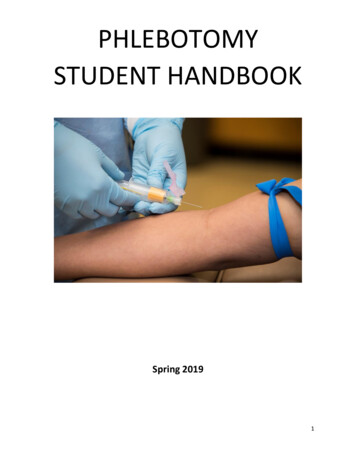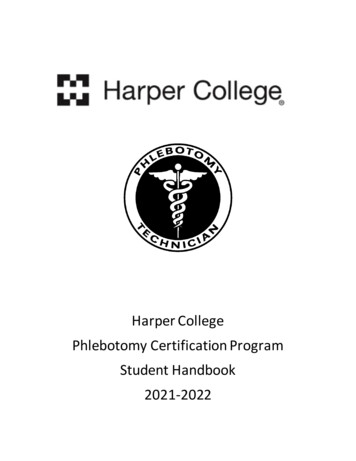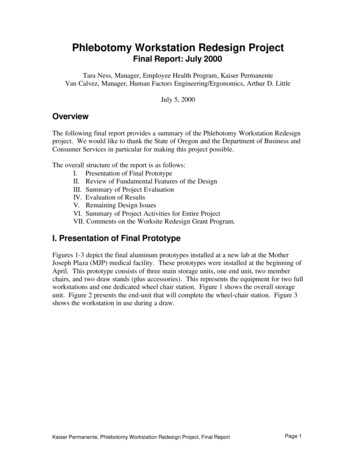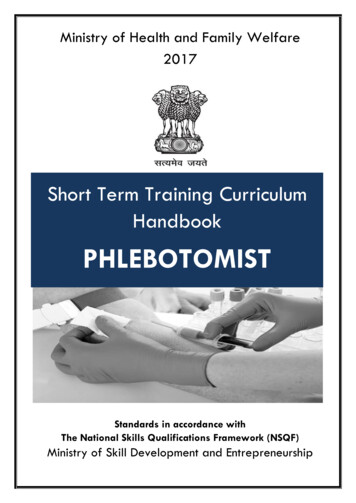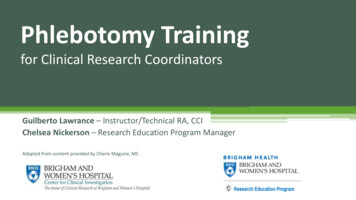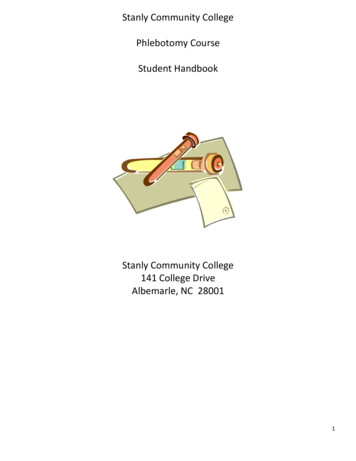
Transcription
College of The AlbemarlePhlebotomy Student HandbookEffectiveJune TRR2015TRR12016TRR2017TRR2018TRR
TABLE OF CONTENTSI.Introduction . 5A.College of The Albemarle Organizational Chart . 6B.Health Sciences Organizational Chart. 7II.Faculty & Staff . . . . . .8III.General Information . 9A.B.C.IV.Admissions . 10A.B.V.Mission Statement . 9Program Goals . 9Student Learning Outcomes . . 9Admission Requirements/Process . 10Special Admission Circumstances (DACA and Undocumented Immigrant Students) 13Progression . 13A.B.C.Class Schedule . 13Attendance. 14Grading System . 15VI.Academic Policies . 15VII.Resources . 15VIII.Essential Functions . 16IX.Liability Insurance . 17X.Disability Services . 18XI.Student Conduct. 18A. Criminal Background/ Drug Screens . 20B. Clinical Performance . 20C. Patient Confidentiality . 21D. Visitors . 21E. Clinical Environment . 21F. Student Service Work Policy . 21XII.Phlebotomy Certification Examination . 22XIII.Dismissal . 22A.B.C.XIV.Appeals Process 25Complaint Policy 26Due Process 26Clinical Dress Guidelines 26
XV.Phlebotomy Curriculum Schedule . . .28A. Certificate .28B. Diploma . .29XVI.Facilities Utilized for Clinical Rotations . . .30XVII.Phlebotomy Student Contractual Agreements .31A.B.C.D.Safety Agreement . .31Venipuncture Consent .33Venipuncture Exemption .34Student Acknowledgement .35
I.IntroductionThis handbook supplements the policies and procedures adopted by the COA Board ofTrustees. In the event of any conflict between a Board of Trustees’ policies or any policy orprovision of this Handbook, the Board of Trustees’ policy shall be construed as setting forth theminimum expectations, rule or procedure applicable. In other words, some components of thepolicies set forth in this Handbook may impose greater obligations, expectations orresponsibilities on students in the Phlebotomy Program than are generally applicable to otherstudents. In the event that a student has a question or concern regarding inconsistencies inthese policies, he/she should direct them to the Program Coordinator. The ProgramCoordinator may confer with the Department Chair, Dean, Vice President of Learning and otheradministrative officials to resolve any such issue or conflict.
6
II. Phlebotomy Faculty/ StaffTerri R. Riddick, BS, MT (ASCP), MPAAssistant Professor; Program CoordinatorMedical Laboratory Technology & Phlebotomyterri riddick@albemarle.eduStaffBethany MarkhamAdministrative Assistant, Health SciencesExtension2999OfficeOC 2072283OC 1022304OC 107bethany markham70@albemarle.eduChris RobertsonDirector, Health Sciences and Wellness ProgramsAdmissions/Advisementchris robertson37@albemarle.edu8
III. General InformationThe COA Phlebotomy Program is a one-semester certificate program. The North CarolinaCollege System, overseen by the State Board of Community Colleges supports the COAPhlebotomy Program. The program of instruction is governed by regulations and requirementsof the North Carolina Community College System and the Institutional Policies of COA.A. Phlebotomy Program Mission StatementThe College of the Albemarle (COA) Phlebotomy Program prepares individuals with theknowledge and skills necessary related to obtaining blood and other specimens for the purposeof laboratory analysis. The COA Phlebotomy Program mission is to provide education andtraining in the field of phlebotomy while maintaining high standards of instruction and servicedelivery. This is accomplished by providing theory and clinical experiences in a professionalenvironment that is conductive to diverse learning needs of students.B. Phlebotomy Program GoalsTo provide sound education resulting in:1. Competent graduates who could serve as quality employees for the healthcarecommunity and who have a working knowledge of phlebotomy and healthcare at theentry level.2. Graduates who have been adequately equipped with the knowledge that will allowthem to successfully pass national certification exams; and,3. A workforce to meet the needs of a growing healthcare community.C. Phlebotomy Program Student Learning OutcomesSuccessfully perform venipuncture by vacuum collection devices.Successfully perform skin puncture to obtain specimen for whole blood testing andserum/plasma testing.List essential information that should be on laboratory requisitions and specimencontainers for identification.Demonstrate appropriate interaction and communication with patients and staffDemonstrate a professional attitude and behavior in the workplace.9
IV. AdmissionsPHASE I: PRE-ADMISSION REQUIREMENTS:Applicants seeking admission into the Phlebotomy program must complete the following steps by June15th 2020 in order to be considered for acceptance for the Fall Semester 2020. (At the discretion of thePhlebotomy Program Coordinator, some applications may be considered after the deadline.)A.Complete and submit a COA Application for Admission, which expressesinterest in the Phlebotomy program, to the Admissions Office, Elizabeth City Campus.B.C.Bring or send an official high school transcript and all official postsecondary transcripts, if applicable, to the Admissions Office.Attendance at a Health Sciences & Wellness Programs (HSWP) OrientationSession is highly recommended, for a review of the admission process. Check withthe admission department or the Health Sciences Admission Coordinator for scheduleddates and times. On-line orientation can be viewed y/b70d20c908fc4b8dba0fdc9320c6dc241dD.Achieve minimum English, Math, and Reading competencies.Minimum English, Reading, and Math competencies must be met and may beaccomplished by a variety of measures, including previous placement test scores,standardized test scores, and/or previous developmental coursework.To qualify for the Phlebotomy program, the student must meet all the prerequisites forENG 111 (without a co-requisite requirement.)To qualify for the Phlebotomy program, the student must meet all the prerequisites forMAT 110 (without a co-requisite requirement.)Note: The course listed is the expected level of minimal competency and may not be a requiredcourse within the program itself. Students should meet with an academic advisor if they do notmeet this requirement and need guidance on course selection.E.Achieve and maintain a 2.0 minimum cumulative grade point average on thetranscript of record (most recent transcript with 12 accredited credit hours or more). If thetranscript of record is not the COA transcript and the student has taken courses at COA,then the COA transcript must also show a 2.0 minimum cumulative grade point average(regardless of the number of hours). If the most recent 12-hour transcript of record is thehigh school transcript, the unweighted GPA will be used. Achieve a minimum of “C”grade on each relevant COA or transfer course. Only grades of “C” or better will beaccepted for point earning, transfer purposes, and program completion.F.Applicants must have completed one unit of biology in high school thatcounts as at least 1 full credit on the transcript - or the equivalent at a postsecondary institution (BIO 090 or higher). An official transcript must be provided.REQUIREMENTS A, B, C, D, E, and F must be met in entirety before applicantsmay complete a Phlebotomy Application. Once students have met criteria A-Fcompletely, they should contact the Health Sciences Admissions Technician(Annette Roberson, Ext 2221) for validation of requirements. One week after10
submitting validation forms, students may contact the HSWP Admissions &Advising Director (Owens Center, Office 107, Ext. 2304), who will confirm theirform has been validated.PHASE II: PHLEBOTOMY APPLICATION REQUIREMENTS:G.COMPLETE THE PHLEBOTOMY ADMISSION APPLICATION.Once students have met all preadmission criteria A, B, C, D, E, and F – studentsmust complete an application for the Phlebotomy Program. Applications may beobtained from the Health Sciences Admission Technician’s office (AE 133). Applicationswill only be given to students who demonstrate completion of preadmission requirementsA-F. Students should call the HSWP office to confirm their form has been received.Only those students who have completed an application form in its entirety will beconsidered for the admission process. Applications must be received in the HSWPAdmissions & Advising Office (Owens Center, Office 107, Ext. 2304) by 4 p.m. onJune 15th 2020.H.ATTEND THE PHLEBOTOMY PRE-ADMISSION MEETING.After meeting the minimum PRE-ADMISSION qualifications for admission to thePhlebotomy program and submitting the Phlebotomy application, qualified applicants willreceive a letter of notice and must attend a mandatory pre-admission meeting with thePhlebotomy faculty. The purpose of the pre-admission meeting is to inform prospectiveapplicants about the Phlebotomy program and answer questions or concerns of theapplicants. Applicants failing to report at the scheduled time for the pre-admission meeting will havetheir names withdrawn from consideration unless they have previously notified the HSWPAdministrative Assistant’s office, Owens Center, Office 102, Extension 2283. It is the applicant’s responsibility to maintain communication with the college via theHealth Science Administrative Assistant’s office, Owens Center, Office 102, Extension2283.PHLEBOTOMY PROGRAM RANKING PROCESSAll students who have met all the required academic and testing criteria, have a complete Phlebotomyapplication and validation form on file, have attended the pre-admission meeting, and have validated theaccuracy of the compiled academic data will be ranked on a first come-first serve basis, based on thedate their validation form was submitted to the Health Sciences Admissions Technician (AnnetteRoberson).PHASE III: SELECTION PROCESSA.Letters of contingent acceptance will be sent to the top applicants for the number ofprogram slots available.B.Letters to other applicants who qualified, but did not place within the allottednumber of slots, will be sent and these applicants will be assigned an “alternate” numberbased on their dated validation form. It is from this alternate list that any vacancies thatoccur prior to the first day of classes may be filled at the discretion of the PhlebotomyProgram Coordinator, whose decision is final, starting with “Alternate 1.”11
C.The admission process ceases and the alternate list is void beginning withthe first day of class in fall semester. Any qualified applicants or alternates whodo not enter the program must begin the admission process again and resubmit allpaperwork in order to be considered and re-compete for the next time the phlebotomyprogram is offered.An applicant who has concerns about the admissions process to the Phlebotomy Programshould contact the Phlebotomy Program Coordinator (Owens Center, Office 207, Ext.2999).OTHER IMPORTANT INFORMATION RELATEDTO THE PHLEBOTOMY PROGRAMUpon conditional acceptance, but prior to enrollment in the Phlebotomy program, applicants willbe required to provide additional information including:A.B.C.The fully completed and signed COA health care examination formindicating physical and emotional health and record of immunizations. Thismust be submitted via the assigned third party vendor and available forreview prior to the beginning of the PBT 101 Practicum. Students who donot meet this requirement may be dropped from consideration for the PBTprogram, even if they have met all other criteria and have initially been accepted intothe program. Students will be required to sign a release to allow the program to providespecific medical information that may be required by authorized clinical sites (example:immunizations record).Criminal background check and/or drug testing may be required by clinical sitesprior to participation in the clinical component of this program. Progress towardgraduation will be limited by any inability to complete the clinical portion of the program.Students with certain misdemeanor or felony convictions may have limited certificationand employment opportunities.Documentation of current BLS CPR Certification through the AmericanHeart Association – must be received by the MLT Program Coordinator prior to thebeginning of the PBT 101 Practicum. Students who do not meet this requirement may bedropped from consideration for the PBT program, even if they have met all other criteriaand have initially been accepted into the program.READMISSION PROCESSDefinition of Re-Admit: A student who has previously been enrolled in any Phlebotomy Program. Applicants applying for readmission into the first semester of the phlebotomy program shouldcontact the Phlebotomy Program Coordinator (ext. 2999) for information concerning this specialsituation.SPECIAL ADMISSION CIRCUMSTANCES – “DEFERRED ACTION FORCHILDHOOD ARRIVALS (DACA)” AND “UNDOCUMENTED IMMIGRANT”STUDENTS12
COA Health Sciences and Wellness programs will allow the admission of students with DACAclassification. However, DACA students should be aware of the following:a. Neither federal law, nor North Carolina law permits individuals with DACA classificationto receive professional licenses. See 8 U.S.C. § 1621(a) and (c)(1)(A). Ability to obtainother certifications may also be limited.b. It is the current position of the State Residence Committee that individuals with DACAclassification do not have the capacity to receive in-state tuition.COA Health Sciences programs will allow the admission of students with “undocumentedimmigrant” classification. However, undocumented immigrant students should be aware of thefollowing:a. For the purposes of this Section, "undocumented immigrant" means any immigrant whois not lawfully present in the United States.b. An undocumented immigrant admitted shall not be considered a North Carolina residentfor tuition purposes.c. Federal law prohibits states from granting professional licenses to undocumentedimmigrants. Ability to obtain other certifications may also be limited.d. Students lawfully present in the United States shall have priority over any undocumentedimmigrant in any class or program of study when capacity limitations exist.V. ProgressionA. Class ScheduleThe Phlebotomy Program is offered via the following pathways: Therapeutic and DiagnosticServices – Phlebotomy Diploma and Phlebotomy Certificate.The Phlebotomy certificate program can be completed in one semester. There are two (2) corephlebotomy courses and three (3) related curriculum courses. The two phlebotomy core coursesinclude PBT 100 (Phlebotomy Technology) and PBT 101 (Phlebotomy Practicum). The threerelated curriculum courses include PSY 101 (Applied Psychology) or PSY 150 (GeneralPsychology), ACA 111 (College Student Success), and CIS 111 (Basic PC Literacy). All five ofthese courses can be completed in one semester, although a student may have completed thePSY101 or PSY 150, ACA 111, and CIS 111 course credits prior to enrolling in the phlebotomyprogram. ACA 111, CIS 111, and PSY 101or PSY 150 are co-requisites or pre-requisites to PBT100 and PBT 101. If a student is enrolled in any or all of the related curriculum courses, alongwith the PBT courses, and he/she withdraws from any of these courses, they will also bewithdrawn from the PBT courses, therefore, withdrawn from the Phlebotomy Program.The Therapeutic and Diagnostic Services- Phlebotomy Diploma requires 40 credit hours. Thesame PBT courses within the certificate program are required, as well as, the general educationcourses that are listed in the curriculum guide. PBT 100 and PBT 101 courses are taught inSpring semesters. These courses have limited space, and are available on a first-come firstserve basis. Class size is capped at 15 students. In order for a diploma to be awarded, all 40credit hours listed on the curriculum guide must be completed.13
The sixteen (16) week semester period is divided into two eight-week sessions for thePhlebotomy classes, PBT 100 and PBT 101. PBT 100 is scheduled and completed during thefirst eight-week session, and PBT 101 is scheduled and completed during the second eightweek session. This allows each student to be able to complete the theory and laboratorycomponents of the program before entering into the clinical component of the program. Theother required classes are scheduled for the entire 16 weeks, unless otherwise stated on thesemester schedule.PBT 100 classroom sessions and/or most lab sessions, are held on the Elizabeth City or theEdenton or Dare campus during the first 8-week session. The second 8-weeks of the semesteris when PBT 101 is completed. The times will vary according to the individual site that isassigned to each student. The days of attendance for the clinical component will be determinedby the student’s class schedule and the facility assigned.A variety of facilities are utilized for clinical rotations. Some of these include local hospitals,private healthcare provider offices, and public health departments.B. AttendanceStudents are expected to attend every meeting of every course in which they are enrolled. If anabsence should occur, it is the responsibility of the student to obtain all class notes, handouts,and assignments given on that day. It is NOT the responsibility of the faculty to seek out thestudent in order to provide this information.Attendance at all scheduled tests is required. Failure to notify the instructor prior to missing ascheduled test will automatically result in a 7-point drop in test grade. It is the responsibility ofthe student to notify the instructor of possible times to reschedule the test. It is stronglyencouraged that the test be rescheduled before the next class meeting, if at all possible.Tardy is defined as not being in the classroom at the scheduled time for the beginning of class.Three (3) tardies will calculate as one hour of absence. A pattern of excessive tardiness isunacceptable and could lead to dismissal.Excessive student absences are defined as in excess of ten percent (10%) of the total coursehours. Students who miss more than 10% of classes will be dropped from the roll. A pattern ofexcessive tardiness and/or absence from the clinical experience may necessitate the student’sassignment in the facility being cancelled, resulting in an unsatisfactory clinical evaluationand/or failure of the course. Any time that is missed during the clinical experience, is theresponsibility of the student to make arrangements with the facility to make up the hours thatwere missed.When inclement weather occurs (snow, storms, etc.), students should listen to local radio andTV stations for information about the closing of the College of The Albemarle. Students mayalso call the main COA number, 252-335-0821, for information.The general attendance policy for the College of the Albemarle can be found in the collegecatalog.14
C. GradingThe Phlebotomy Program follows the grading system described in the College of the AlbemarleCatalog. It is as follows:A93-100B85-92C77-84D70-76Fless than 70The student receives separate grades for each Phlebotomy course. The method ofgrade determination for each course is included in specific course syllabi. A grade of Cor better is required for PBT 100 (theory and laboratory components) the first 8 weeks ofthe semester and PBT 101 (clinical component) the second 8 weeks of the semester.VI. Academic RegulationsThe Academic Standards and Discipline Policy as found in the College of the Albemarle Catalogare adhered to for the Phlebotomy Program.VII. ResourcesThe main phlebotomy lab is Owens Center Room 215. This space is shared with the MedicalLaboratory Technology Program. The lab contains equipment that will be utilized during thecourse of the semester. Please do not experiment with the equipment that you are unfamiliarwith and have not covered in class. It is up to the students and faculty to maintain the classroomand equipment in proper order. Should you become aware of any materials or equipment that isnot in proper working order, please report it immediately to the faculty. Material should not beremoved from the classroom area without specific permission.The College of the Albemarle Library and computer lab have various texts and software relatedto phlebotomy and other health care areas. In addition, Internet access is available in the library,computer lab, and the phlebotomy classroom.Student Success and Enrollment Management provides programs designed to increase studentretention and graduation rates, and promote a climate of support for the students. AcademicSupport services can help you develop study skills, test-taking abilities, and provide tutorialservices for general education courses. If the student requires tutoring for PBT (Phlebotomy)course, he/she should contact the Phlebotomy Program Coordinator. Student Success andEnrollment Management is located in the AE-building and Academic Support is located in the Cbuilding on the Elizabeth City campus. Students attending the Dare campus can receiveinformation at (252) 473-2264.15
VIII.Essential Functions of the Phlebotomy StudentThe safe practice of phlebotomy involves cognitive, sensory, affective, and psychomotorperformance requirements. Therefore, the essential eligible requirements for students in thephlebotomy program shall be further defined according to the following standards.Physical and Emotional Standards:Phlebotomy students should possess and be able to demonstrate the following:1. Interpersonal Skills – Inter personal abilities sufficient to interact withindividuals, families, and other health care professionals from a variety ofemotional, cultural, and intellectual backgrounds. For example, the phlebotomystudent shall establish rapport with patients/clients and the health care teammembers.2. Communication Skills – Communication abilities sufficient for interaction withothers in the verbal and written form. For example, explain the venipunctureprocedure to a patient/client.3. Cognitive Abilities - Ability to be oriented to time, place, and person:organization responsibilities, and making decisions. For example, recognize andreport physical problems that occur when attempting venipuncture on a givenpatient/client.4. Mobility – Physical abilities sufficient to move from room to room and aroundpatients in a wide range of positions, maneuver in small spaces, to bend, stoop,kneel, squat; stand and walk for extensive periods of time; and sufficient balanceto enable carrying various items when walking. For example, trips from thelaboratory to patient/client rooms.5. Motor Skills – Gross and fine motor skills sufficient to provide safe phlebotomyprocedures. For example, demonstrate proper needle insertion and withdrawaltechnique when performing venipunctures.6. Hearing – Auditory ability sufficient to monitor health needs of patients/clients.For example, hear monitor alarms, emergency signals, patient/client requests.7. Visual – Visual ability sufficient for observation and skills necessary inphlebotomist duties. For example, observe patient/client response tovenipuncture, changes in specimen color, and accurately read letters, numbers,and/or symbols at least 1/16 of an inch of larger from a safe distance.8. Tactile – Tactile ability sufficient for collecting specimens. For example, identifypotential sites for venipuncture, capillary, and arterial punctures.9. Health Status - Students who pose a risk to the health, safety or well-being ofpatients or other students, whether due to infectious diseases or otherwise, maybe removed from clinical settings. If a student should contract or be a carrier of16
any infectious disease whether acute, chronic, active or inactive, it is thestudent’s responsibility to report this immediately to the course/clinical instructor.Patient wellbeing, safety and health are the primary concerns of all clinicalfacilities and clinical sites. All clinical sites and clinical facilities, as well as COA,reserve the right to require medical verification that a student may participate in aclinical setting without posing a risk to the health, safety or well-being of patients,other students or staff.The College may take a number of steps and precautions at all campuses providingadditional information and resources related to COVID 19 for students; implementingadditional health and safety protocols; adjusting some facility, physical space andcampus operations; and modifying classes and academic delivery as needed.Students should understand that COVID-19 and other communicable diseases are apublic health risk; that COA and clinical facilities cannot guarantee safety or immunityfrom any infection; and that each student voluntarily assumes all risks associated withparticipating in health science programs related activities on campus and at clinicalfacilities, including the risk of exposure or infection with COVID-19 and other infectiousdiseases.The above examples are illustrative only and are not all inclusive! If a student or applicantbelieves that he or she cannot meet one of the standards without accommodations ormodifications, the student should confer directly with the program coordinator to determinewhether or not any additional accommodations can be provided and whether suchaccommodations are feasible. Students needing any form of accommodation are expected toengage in an interactive process with the program coordinator, and any other administrativeofficials, to determine what modifications or accommodations may be reasonable andappropriate.Religious Observance PolicyIn compliance with the North Carolina Administrative Code, Title 23, Chapter 2, Sub-Chapter2C, Section .0213 requirement as authorized by Section 115D of the NC General Statutes,College of The Albemarle will grant any student of the College two excused absences eachacademic year for religious observances required by the faith of the student. The two excusedabsences may be taken at any time during the academic year either on separate days or on twoconsecutive days and must be taken within the absences allowed in the College’s approvedattendance policy as published in the COA Academic Catalog and specific program handbooksfor those students enrolled in a program. Students must submit a “Request to be Excused ForReligious Observance Form” to the Vice President of Student Success and EnrollmentManagement within the first two weeks of the semester in which the absence will occur.IX. Liability InsuranceEach student is required to have Liability insurance. Phlebotomy students are enrolled in agroup policy through C. Berry & Smith Insurance Company with the premium being paid by the17
applicant to the Business Office tuition and fees are collected. Applicants who enter the programmust pay their insurance prior to enrollment in clinical course during the summer semesters.X. Disability Services StatementCollege of The Albemarle seeks to comply with the Americans with Disabilities Act and Section 504 ofthe Rehabilitation Act. Section 504 is a Federal Civil Rights Law, which pro
Phlebotomy program and submitting the Phlebotomy application, qualified applicants will receive a letter of notice and must attend a mandatory pre-admission meeting with the Phlebotomy faculty. The purpose of the pre-admission meeting is to inform prospective applicants about the Phlebotomy program and answer questions or concerns of the .

